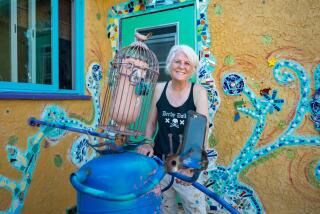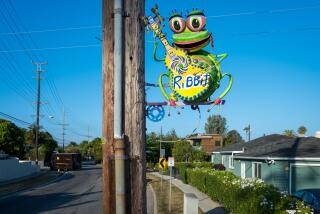Camarillo State Hospital Program Judged a Success : Art Classes Provide Outlet for Patients’ Inner Turmoil
The paint-speckled tables may be loaded with every art supply imaginable, but the art studio at Camarillo State Hospital still doesn’t seem equipped to teach the residents of Unit 25.
A bony and pockmarked man named Joe rocks idly in a chair, his lips silently fluttering. A pale classmate named Bob giggles continuously at an inner stream of amusement. And James, a strapping man with wild eyes, accuses his instructor of plotting to kill him.
“I’m getting bad vibes,” he warns.
An hour into their weekly art class, however, these chronically disturbed patients are immersed in painting, drawing and sculpture, thanks to an art therapy program introduced two years ago at the hospital, home to 1,225 mentally ill and developmentally disabled men, women and children.
James puts the finishing touches on a delicate clay horse between whose legs curls a two-inch human figure. Bob giggles at the Impressionist desert scene that he has just drawn in pastels. And a stack of quickly rendered but expressive drawings lie in front of Joe.
‘Lot of Feeling’
“There’s a lot of feeling in your work,” art therapist Jack Cheney tells Bob, surveying a brightly colored landscape in which a lake climbs over the horizon and into the air. “There are people with degrees in art who wish they had that power.”
About 100 hospital residents who take 15 weekly classes from Cheney have been no less productive.
Their work has filled two weeklong art shows at the hospital and garnered ribbons at the Ventura County Fair. It has been exhibited in the lobby of the Santa Paula Theater Center, during a production of “The Hothouse,” a Harold Pinter play about a mental institution.
And hospital officials plan to open an art gallery next month where the works will be permanently displayed.
The gallery, which will be open to the public on weekdays, will assemble hundreds of paintings, drawings and sculptures in the foyer and hallway of the hospital’s Hagerty Building. Purchases can be arranged by calling Cheney at the hospital.
Hospital administrators hope that the gallery, tentatively named Personal Images, will help form a positive impression for the Spanish-style hospital, on a verdant 370-acre campus four miles south of Camarillo.
“We’ve gone so far beyond the Nurse Ratched days,” Cheney said, referring to the tyrannical nurse in the movie “One Flew Over the Cuckoo’s Nest,” Ken Kesey’s portrayal of life in a mental institution in the 1950s. “Things have really changed.”
He said one hope is that the display of artwork will help build the self-esteem of the residents, who will receive the proceeds from sales.
“For all that’s wrong with them,” Cheney said, “there’s an awful lot that is right. We want to focus on that.”
People who have seen it are impressed with the art’s expressiveness.
“It has such vitality and vigor, a real vibrancy that most painters don’t have,” said Jackie Wallace, an art teacher who has volunteered at the hospital.
The work often lacks the self-consciousness seen in amateur art, said John Nichols, an art gallery owner who helped with the Santa Paula exhibition.
“When you’re professional, you’ve gone beyond technique,” he explained. “You’re just expressing the self. So it is with the work of the Camarillo people. It goes to the soul of the artist.”
Consider the intricate pencil drawings of the Camarillo patient who has yet to recover from the psychotic episode that he experienced years ago in front of an Aztec temple in Mexico. The drawings depict stylized ancient Indian warriors and Spanish conquistadors in dance-like movements.
Or the ceramic self-portrait of the patient who fried his brain on drugs. Vacant-eyed beneath bright pink glaze, the bust rises into an exploding mushroom cloud.
‘It Grabs You’
Or the figurines over which James, a schizophrenic, labored in a recent class. He explained that they depict a night when he slept between the legs of five white stallions on the grounds of the San Buenaventura Mission.
“This is not the sort of stuff being sold in the supermarket parking lot,” said Tom Considine, a supervisor at the hospital. “It grabs you.”
The artwork is also reasonably priced. The hospital’s patients usually set the prices for their works in the $5-to-$15 range. At the last show, about 200 works were sold for about $1,200.
The program’s success has been traced to Cheney, 38. A boyish father of five who helped support his family for 14 years as a professional sculptor, he came to the hospital two years ago while completing a graduate degree in art therapy at Cal State Los Angeles.
At the time, a daylong version of the art show had been going on for two years but no formal art therapy program had been established because hospital officials were unable to find anyone up to the task.
‘He’s Really Got a Knack’
“It’s hard to find a good art teacher who likes to work with the mentally ill,” said Bamford Franklin, deputy director of the state Department of Developmental Services, which created Cheney’s post a year ago. “When you find someone really good, you’ve got a treasure, and Jack’s one. He’s really got a knack.”
Cheney cheerfully juggles the demands of people with short attention spans, people who are motivated by inner voices and needs that always strike them as urgent.
The class for Unit 25 residents, most of whom have been so ravaged by drugs or schizophrenia that they have little hope of being released, was typical.
Cheney was busy. He had to keep an eye on one man who was trying to get high on water--overconsumption produces a giddy feeling--and at the same time, teach another patient to tie-dye, and start James, the horse sculptor, on another project in clay.
But Cheney said it is his dream job, explaining: “I’ve always wanted to address the pain, isolation and suffering I see in people.”
And pain and suffering there is. Take a recent class for six boys between 12 and 16 who, at first glance, appeared to differ little from other boys their age.
Told to outline one hand and fill the space with designs that reflected his state of mind, a boy who hears voices that instruct him to injure himself drew a network of bloody sores.
A frail blond boy, who also hears voices, painted his ring finger orange because “people think I’m ugly.”
And a bright and affable boy who landed in the hospital after being physically abused by relatives ran a harsh gray scrawl through his drawing to represent his fellow patients, explaining that they terrified him.
Such exercises enable people to explore feelings “one step removed” from themselves, said Evelyn Virshup, a Cal State Los Angeles art therapy instructor and the author of “Right Brain People in a Left Brain World,” a study of art-therapy techniques applied to drug addicts.
“You can explore yourself at a distance,” she explained. “It makes it much easier.”
But such exploration often requires flexibility, as Cheney soon learned.
In one of his first classes, he had no luck attracting the attention of four disturbed boys--”a platoon of hyperkinetic commandos”--until one tucked himself in a box he found in the studio. Soon Cheney had them all designing “womb-like” houses from other boxes. Eventually, the group went on to build a permanent clubhouse of bamboo outside their dormitory.
Using art as a means to inner peace is perhaps as old as time, but its use in psychotherapy dates to the 1940s, with art therapy becoming a recognized profession in the 1960s.
More to Read
Sign up for Essential California
The most important California stories and recommendations in your inbox every morning.
You may occasionally receive promotional content from the Los Angeles Times.










